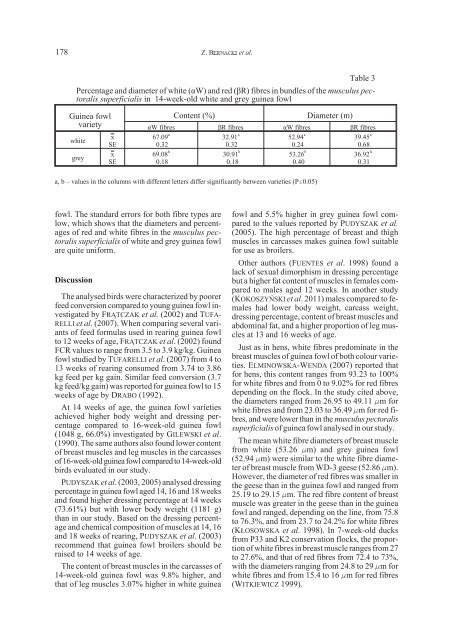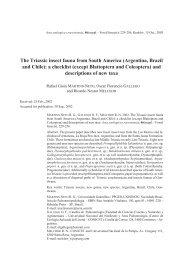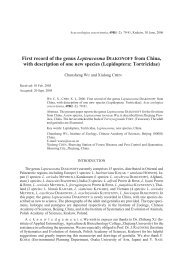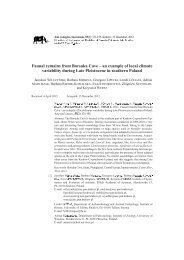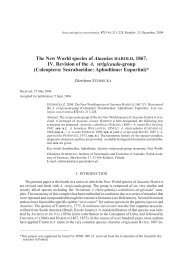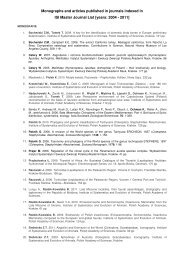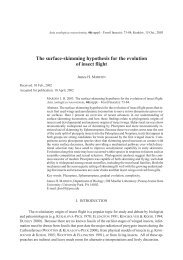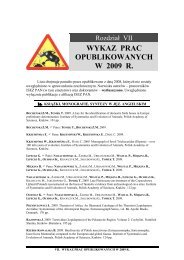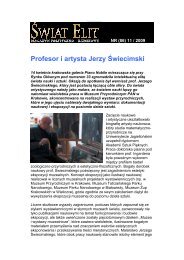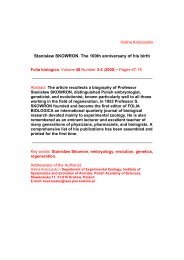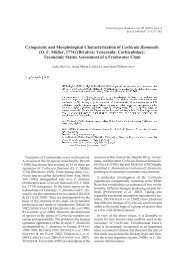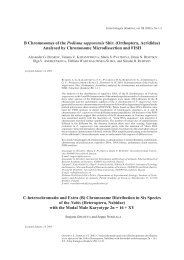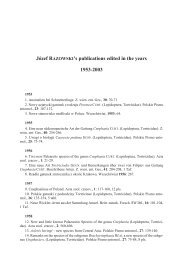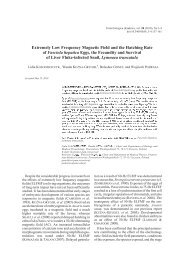Carcass composition and breast muscle microstructure in guinea fowl
Carcass composition and breast muscle microstructure in guinea fowl
Carcass composition and breast muscle microstructure in guinea fowl
Create successful ePaper yourself
Turn your PDF publications into a flip-book with our unique Google optimized e-Paper software.
178<br />
Z. BERNACKI et al.<br />
Table 3<br />
Percentage <strong>and</strong> diameter of white (áW) <strong>and</strong> red (âR) fibres <strong>in</strong> bundles of the musculus pectoralis<br />
superficialis <strong>in</strong> 14-week-old white <strong>and</strong> grey gu<strong>in</strong>ea <strong>fowl</strong><br />
Gu<strong>in</strong>ea <strong>fowl</strong><br />
variety<br />
white<br />
grey<br />
x<br />
SE<br />
x<br />
SE<br />
Content (%)<br />
Diameter (m)<br />
áW fibres âR fibres áW fibres âR fibres<br />
67.09 a<br />
32.91 a<br />
52.94 a<br />
39.45 a<br />
0.32<br />
0.32<br />
0.24<br />
0.68<br />
69.08 b<br />
0.18<br />
30.91 b<br />
0.18<br />
53.26 b<br />
0.40<br />
36.92 b<br />
0.31<br />
a, b – values <strong>in</strong> the columns with different letters differ significantly between varieties (P0.05)<br />
<strong>fowl</strong>. The st<strong>and</strong>ard errors for both fibre types are<br />
low, which shows that the diameters <strong>and</strong> percentages<br />
of red <strong>and</strong> white fibres <strong>in</strong> the musculus pectoralis<br />
superficialis of white <strong>and</strong> grey gu<strong>in</strong>ea <strong>fowl</strong><br />
are quite uniform.<br />
Discussion<br />
The analysed birds were characterized by poorer<br />
feed conversion compared to young gu<strong>in</strong>ea <strong>fowl</strong> <strong>in</strong>vestigated<br />
by FR¥TCZAK et al. (2002) <strong>and</strong> TUFA-<br />
RELLI et al. (2007). When compar<strong>in</strong>g several variants<br />
of feed formulas used <strong>in</strong> rear<strong>in</strong>g gu<strong>in</strong>ea <strong>fowl</strong><br />
to 12 weeks of age, FR¥TCZAK et al. (2002) found<br />
FCR values to range from 3.5 to 3.9 kg/kg. Gu<strong>in</strong>ea<br />
<strong>fowl</strong> studied by TUFARELLI et al. (2007) from 4 to<br />
13 weeks of rear<strong>in</strong>g consumed from 3.74 to 3.86<br />
kg feed per kg ga<strong>in</strong>. Similar feed conversion (3.7<br />
kg feed/kg ga<strong>in</strong>) was reported for gu<strong>in</strong>ea <strong>fowl</strong> to 15<br />
weeks of age by DRABO (1992).<br />
At 14 weeks of age, the gu<strong>in</strong>ea <strong>fowl</strong> varieties<br />
achieved higher body weight <strong>and</strong> dress<strong>in</strong>g percentage<br />
compared to 16-week-old gu<strong>in</strong>ea <strong>fowl</strong><br />
(1048 g, 66.0%) <strong>in</strong>vestigated by GILEWSKI et al.<br />
(1990). The same authors also found lower content<br />
of <strong>breast</strong> <strong>muscle</strong>s <strong>and</strong> leg <strong>muscle</strong>s <strong>in</strong> the carcasses<br />
of 16-week-old gu<strong>in</strong>ea <strong>fowl</strong> compared to 14-week-old<br />
birds evaluated <strong>in</strong> our study.<br />
PUDYSZAK et al. (2003, 2005) analysed dress<strong>in</strong>g<br />
percentage <strong>in</strong> gu<strong>in</strong>ea <strong>fowl</strong> aged 14, 16 <strong>and</strong> 18 weeks<br />
<strong>and</strong> found higher dress<strong>in</strong>g percentage at 14 weeks<br />
(73.61%) but with lower body weight (1181 g)<br />
than <strong>in</strong> our study. Based on the dress<strong>in</strong>g percentage<br />
<strong>and</strong> chemical <strong>composition</strong> of <strong>muscle</strong>s at 14, 16<br />
<strong>and</strong> 18 weeks of rear<strong>in</strong>g, PUDYSZAK et al. (2003)<br />
recommend that gu<strong>in</strong>ea <strong>fowl</strong> broilers should be<br />
raised to 14 weeks of age.<br />
The content of <strong>breast</strong> <strong>muscle</strong>s <strong>in</strong> the carcasses of<br />
14-week-old gu<strong>in</strong>ea <strong>fowl</strong> was 9.8% higher, <strong>and</strong><br />
that of leg <strong>muscle</strong>s 3.07% higher <strong>in</strong> white gu<strong>in</strong>ea<br />
<strong>fowl</strong> <strong>and</strong> 5.5% higher <strong>in</strong> grey gu<strong>in</strong>ea <strong>fowl</strong> compared<br />
to the values reported by PUDYSZAK et al.<br />
(2005). The high percentage of <strong>breast</strong> <strong>and</strong> thigh<br />
<strong>muscle</strong>s <strong>in</strong> carcasses makes gu<strong>in</strong>ea <strong>fowl</strong> suitable<br />
for use as broilers.<br />
Other authors (FUENTES et al. 1998) found a<br />
lack of sexual dimorphism <strong>in</strong> dress<strong>in</strong>g percentage<br />
but a higher fat content of <strong>muscle</strong>s <strong>in</strong> females compared<br />
to males aged 12 weeks. In another study<br />
(KOKOSZYÑSKI et al. 2011) males compared to females<br />
had lower body weight, carcass weight,<br />
dress<strong>in</strong>g percentage, content of <strong>breast</strong> <strong>muscle</strong>s <strong>and</strong><br />
abdom<strong>in</strong>al fat, <strong>and</strong> a higher proportion of leg <strong>muscle</strong>s<br />
at 13 <strong>and</strong> 16 weeks of age.<br />
Just as <strong>in</strong> hens, white fibres predom<strong>in</strong>ate <strong>in</strong> the<br />
<strong>breast</strong> <strong>muscle</strong>s of gu<strong>in</strong>ea <strong>fowl</strong> of both colour varieties.<br />
ELMINOWSKA-WENDA (2007) reported that<br />
for hens, this content ranges from 93.23 to 100%<br />
for white fibres <strong>and</strong> from 0 to 9.02% for red fibres<br />
depend<strong>in</strong>g on the flock. In the study cited above,<br />
the diameters ranged from 26.95 to 49.11 m for<br />
white fibres <strong>and</strong> from 23.03 to 36.49m for red fibres,<br />
<strong>and</strong> were lower than <strong>in</strong> the musculus pectoralis<br />
superficialis of gu<strong>in</strong>ea <strong>fowl</strong> analysed <strong>in</strong> our study.<br />
The mean white fibre diameters of <strong>breast</strong> <strong>muscle</strong><br />
from white (53.26 m) <strong>and</strong> grey gu<strong>in</strong>ea <strong>fowl</strong><br />
(52.94m) were similar to the white fibre diameter<br />
of <strong>breast</strong> <strong>muscle</strong> from WD-3 geese (52.86m).<br />
However, the diameter of red fibres was smaller <strong>in</strong><br />
the geese than <strong>in</strong> the gu<strong>in</strong>ea <strong>fowl</strong> <strong>and</strong> ranged from<br />
25.19 to 29.15m. The red fibre content of <strong>breast</strong><br />
<strong>muscle</strong> was greater <strong>in</strong> the geese than <strong>in</strong> the gu<strong>in</strong>ea<br />
<strong>fowl</strong> <strong>and</strong> ranged, depend<strong>in</strong>g on the l<strong>in</strong>e, from 75.8<br />
to 76.3%, <strong>and</strong> from 23.7 to 24.2% for white fibres<br />
(K£OSOWSKA et al. 1998). In 7-week-old ducks<br />
from P33 <strong>and</strong> K2 conservation flocks, the proportion<br />
of white fibres <strong>in</strong> <strong>breast</strong> <strong>muscle</strong> ranges from 27<br />
to 27.6%, <strong>and</strong> that of red fibres from 72.4 to 73%,<br />
with the diameters rang<strong>in</strong>g from 24.8 to 29m for<br />
white fibres <strong>and</strong> from 15.4 to 16m for red fibres<br />
(WITKIEWICZ 1999).


